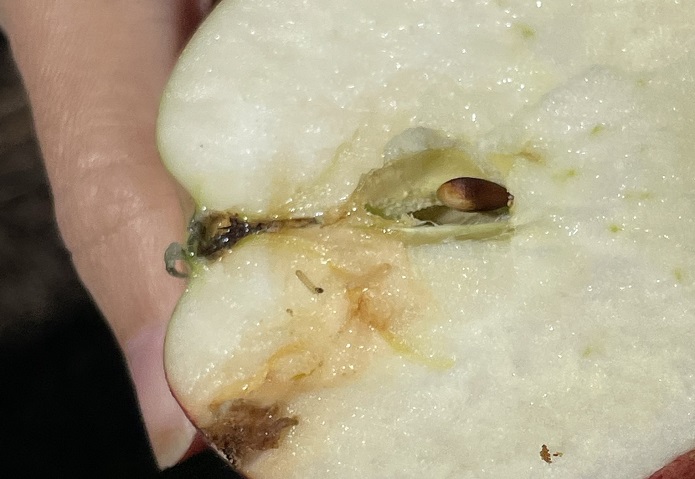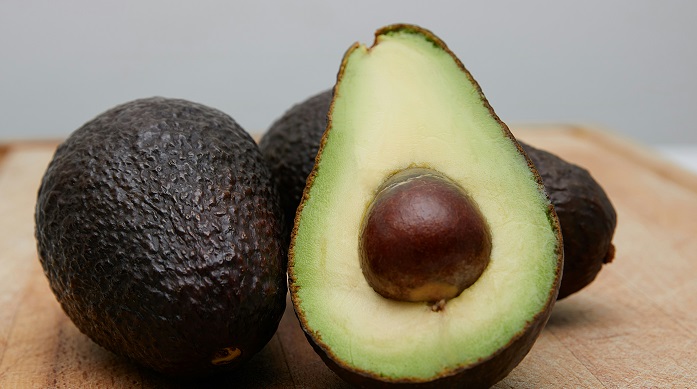Moving artifacts on CT (computer tomography) scans proved to be the key to a major innovation in biosecurity threat detection for CSIRO's Dr Maryam Yazdani and Dr Ben James.
Ben leads the X-Ray Imaging team in the Mineral Resources team, based at Lucas Heights, NSW. His focus is on minerals imaging, including development of real-time ore-sorting—pre-processing scans to reject any rock without target minerals, that would otherwise go through intensive and costly processing.
"Ore-sorting is the holy grail of the mineral industry," he says. His targets are tiny valuable mineral particles (<1mm) embedded in rock.
But this time was different. Ben was imaging apples for signs of codling moth, a cross-domain application in collaboration with Maryam, who leads the Pest Detection Technologies in the Health and Biosecurity team, based in Brisbane.

"We want to improve border fruit inspection methods," she says. "Currently, fruits are subsampled at the border, with the fate of entire consignments determined by the result. It's laborious, time-consuming and expensive," says Maryam. "Mineral resources scanning technologies offered increased speed and accuracy, and the potential for automation," she adds.
"Requirements for real-time ore sorting are the same as those for pest detection—high precision, resolution, speed and accuracy—just the sample material changes," Ben said.
Artifacts provided the key
Initially, we put infested fruit into the CT scanner to visualise the damage and see if we could detect the pests," Ben adds.
This proved challenging. The CT clearly identified pest damage but, “we were getting artefacts in the final images and spent time trying to get rid of them before realising these were coddling moth larvae moving within the apples during the scan.” A CT scan collects 360o worth of images as it spins, with artifacts produced if any part of the subject moves.
Because the larvae were moving enough to produce these CT-scan artifacts, the team looked for signs of the same movement on pairs of 2D X-Ray images taken of the same fruit a second apart (time lapse). Tracks eaten in the apples appeared once again—as did the shift in position by the moth larvae. Movement was detectable with X-ray.
X-Ray was used in subsequent trials, as a cheaper, lower maintenance and faster alternative to CT. Clearly the technology had potential biosecurity applications, given the motion capture and the tracks.
"We went in with the lens that the system should be reasonably applicable across disciplines, although we expected customisation to be necessary," says Ben.
Autonomous Sensors Future Science Platform (ASFSP)
Funding was sourced through the ASFSP, a five-year CSIRO research and development (R&D) program aimed at advancing Australian industry through "the development of truly autonomous platforms and novel sensors, or the improvement of existing sensors," says Dr Yulia Uvarova, ASFSP’s Director.
"Our dynamic core team of early career researchers, postdocs and engineers tackle hard research challenges, addressing issues expected to arise within seven to 10 years," she adds.
Focussed on increasing accuracy, sensitivity, traceability and resolution, applications include environmental monitoring, health tech, biosecurity, manufacturing, agriculture and mining.
Australia's fruit industry needs X-ray biosecurity capability

Ben, and Maryam's postdoc, Dr Jiasheng Su, tested X-rays' effectiveness on fruit fly in blueberries, cherries, apples, avocados and mangos, seed weevil in mangos, codling moth in apples, and carob moths and Carpophilus beetles in almonds.
Pest infestation is a significant challenge for our horticultural industries, particularly when external damage is not visible on the fruit. There is a lot of interest in technologies capable of detecting and rejecting infected fruits before packing.
Biosecurity X-ray proof of concept
"Proof of concept X-Ray trials were successful on single pieces of fruit, finding damage, larvae, pupae and movement, everything," Maryam says.
Jiasheng did much of the image processing and is developing machine-learning algorithms to automate detection of damage and of larval insects. "A complex task given variability in damage patterns and the size of insects," says Ben.
"Distinguishing pest from apple is a very different challenge to separating minerals from rock," adds Yulia.
Testing bulk produce is the next hurdle. "We are scanning fruit in boxes to understand the effect of increased volume, and designing a prototype conveyer system to test time-lapse imagery at speed," says Ben. An X-ray emitter will sit above the conveyer belt and send short, concentrated X-ray pulses through the fruit to the detector below. Commercial-level high-throughput volume is going to be dependent on a how fast high-resolution images can be taken. "We should be able to get really high resolution on images of fruit," says Ben.
Ben adds, "we are also pushing the machine learning, given that fruit damage patterns and pest locations vary consistently with pest species. To explore this diagnostic potential, we'll match fruit scans with pest verification and feed that into our machine learning."
Path to commercialisation
"We are still at proof-of-concept stage", says Yulia. "If bulk trials are successful, we follow with case studies under industry conditions. If they work, we look at scaling up. The team will also continue exploring other applications for this novel technology."
Maryam says, "The opportunity to combine X-ray imaging, computational and biosecurity expertise will leverage CSIRO's X-ray imaging advances in mining to create imaging technology which would not only revolutionise biosecurity, but with adaptation, can be applied across multiple domains such as agriculture and mining metal recovery."
